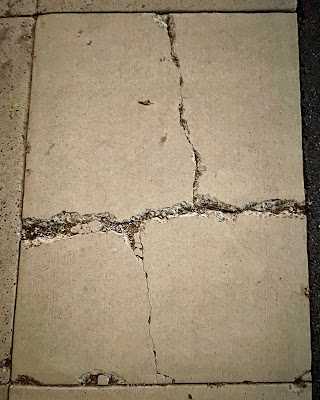Rainbow Stained Glass
Contents
Hello, Hive 1! Here we are, at the end of the year! Hopefully this will be a quick block for you as we approach the holidays. I’m pretty sure it’s going to take you longer to read this post than it will to assemble the block.
For my block I’ve chosen a stained-glass design. There’s a sidewalk paver near my office that I see when I take my work walks, and every time I walk over it, I think about what a cool quilt block it would make.

So, here we are!
Here is an inspiration quilt I found online, just for a sort-of idea about what was in my brain.







Fabric
I am requesting that the for the “glass” you use any of the colors from Gilbert Baker’s original eight-color pride flag, which includes not just the ROYGBV we see in standard (and progressive) pride flags today, but also pink and teal.

I’m fine with solids, blenders, or anything with a relatively small print that reads as mostly the intended color. Although, as you can see in a couple of the sample blocks I did—well, okay, all of them—I didn’t hold myself too closely to those parameters. I’m going more for the spirit of the law, rather than the letter.
Batiks are fine! As are “accent” fabrics that are rainbow-themed, such as the “heat map” fabric in my second sample block, or the rose in my third sample block. I’d ask that you don’t do a whole block with that sort of fabric, but one pane of glass would be fine! Also, the wee birds in the fourth sample block are maybe a bit bigger than what I’d aim for, for a blender, but they’re just so cute! I figure when it’s spread out over the whole quilt, it’ll look cool.

Solids, blenders, and small prints

An idea of rainbow-type fabrics that would be fine!
If you can, please use at least two different fabrics for the glass, for at least a little variety within each block.
Also don’t worry TOO much about making your block too…cohesive or attractive within itself. If your block ends up looking weird like this…

…I won’t be upset. :) I figure once it’s all put together, it’s all going to balance itself out anyway. Or maybe not, and the whole thing will look weird!! Either way, I’m going to love it.

For the cames / sashing, I’m asking for a dark gray / charcoal, or something in that ballpark. The color I used in my samples is very close to Michael Miller Color Couture Metal (SC5333-META-D). Solid, blender, or something with a very small print that reads solid from 10 feet away—those are all fine.
My grays were not interested in looking good alone in a photo, so here they are mixed with some colorful fabrics to give you an idea. They still don’t look quite the same as they do to the naked eye. The leftmost is maybe a bit lighter (in real life) than I’m going for but would be okay. Second gray from the left is the one from my samples. Rightmost has tiny bats and is a good example of a tone-on-tone sort of print that would be fine.

Left to right: 1) Kona Solid Coal; 2) the one used in my samples (unnamed solid FQ!);
3) Michael Miller Color Couture, Metal; 4) Riley Blake Seasonal Basics, Bat Black (C651-BLACK)
The Block
The block I am requesting is about 11” x 11”. Don’t worry about trimming it when you’re done—I’ll do that as I assemble the quilt.
This is a very whim-friendly block. My instructions are for a “starter block.” You can follow them to a T, or you can make modifications along the way as you see fit. Please feel free to be as creative as you like—or not! It's been a long year; no one needs to stress about doing something "creative"!
Cutting instructions
Notes & Tips:
- Read all instructions before you begin cutting and assembling.
- While all the sashing should be 1” (.5” finished), the below cutting instructions for the glass panes are just guidelines—if you’d like to use different dimensions, please feel free!
- For example, if a scrap you want to use for unit B is 3.5” x 4.25” (rather than 4.25” x 4.25”), then you could cut the following to compensate for the difference: C: 7.5” x 6.75”, D: 3.5” x 6.75”, E: 7.5” x 4.25”.
- If you don’t have any scraps you want to use that are as big as 6.75” x 6.75”, consider my rose sample above, which creates the C/E side with three panes rather than two. For that example, you would need additional sashing.
- If you don’t want to worry about the sashing being exactly the right length after you’ve sewn it, cut your A units a bit longer than 11”.
| PIECES TO CUT | |
| Cames / sashing from charcoal fabric | Glass panes from rainbow fabrics (2, 3, or 4 different fabrics) |
| A: (2) 1” x 11” |
B: (1) 4.25” x 4.25” C: (1) 6.75” x 6.75” D: (1) 4.25” x 6.75” E: (1) 6.75” x 4.25” |
Assembly
Notes & Tips:
- All seams are ¼”.
- To chain piece, cut one A unit into two pieces first (4.25” and 6.75”), and then Steps 1 and 5 can be done consecutively; then Steps 2 and 6; then Steps 3 and 7.
- The finished block should be about 11” x 11”. Don’t worry if it’s a little smaller.
- Again, don’t worry about trimming the edges!
Here we go!
- Sew one A unit to an edge of the B unit.
- Sew a short edge of the D unit to the remaining long edge of A from Step 1.
- Press seams open.
- Trim the excess A unit (carefully; you need the rest in the next step).
- Sew the excess of the A unit from Step 4 to an edge of the C unit.
- Sew a long edge of the E unit to the remaining long edge of A from Step 5.
- Press seams open.
- If you haven’t already, decide now how you want the finished block to lay out—you have multiple options, depending on which way you turn the units from Steps 4 and 7, particularly if any of your fabrics are directional, patterned, or ombre.
- Keeping your Step 4 unit oriented the way you decided in Step 8, sew the remaining A unit to a long edge of Step 4.
- Keeping your Step 7 unit oriented the way you decided in Step 8, sew a long edge of the Step 7 unit to the remaining long edge of A from Step 9.
- Press seams open.
- Celebrate!
I hope this was a low-stress block to wrap up our StashBee year!
Thank you for sewing for—and with!—me!
Molli B.









No comments:
Post a Comment